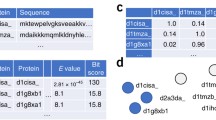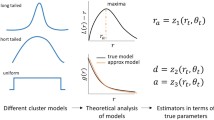Abstract
Cell biologists have developed methods to label membrane proteins with gold nanoparticles and then extract spatial point patterns of the gold particles from transmission electron microscopy images using image processing software. Previously, the resulting patterns were analyzed using the Hopkins statistic, which distinguishes nonclustered from modestly and highly clustered distributions, but is not designed to quantify the number or sizes of the clusters. Clusters were defined by the partitional clustering approach which required the choice of a distance. Two points from a pattern were put in the same cluster if they were closer than this distance. In this study, we present a new methodology based on hierarchical clustering to quantify clustering. An intrinsic distance is computed, which is the distance that produces the maximum number of clusters in the biological data, eliminating the need to choose a distance. To quantify the extent of clustering, we compare the clustering distance between the experimental data being analyzed with that from simulated random data. Results are then expressed as a dimensionless number, the clustering ratio that facilitates the comparison of clustering between experiments. Replacing the chosen cluster distance by the intrinsic clustering distance emphasizes densely packed clusters that are likely more important to downstream signaling events.
We test our new clustering analysis approach against electron microscopy images from an experiment in which mast cells were exposed for 1 or 2 minutes to increasing concentrations of antigen that crosslink IgE bound to its high affinity receptor, FcϵRI, then fixed and the FcϵRI β subunit labeled with 5 nm gold particles. The clustering ratio analysis confirms the increase in clustering with increasing antigen dose predicted from visual analysis and from the Hopkins statistic. Access to a robust and sensitive tool to both observe and quantify clustering is a key step toward understanding the detailed fine scale structure of the membrane, and ultimately to determining the role of spatial organization in the regulation of transmembrane signaling.
Similar content being viewed by others
References
Andrews, N. L., Lidke, K. A., Pfeiffer, J. R., Burns, A. R., Wilson, B. S., & Oliver, J. M. (2008). Actin restricts FcϵRI diffusion and facilitates antigen induced receptor immobilization. Nat. Cell Biol., 10(8), 955–962.
Andrews, N. L., Pfeiffer, J. R., Martinez, A. M., Haaland, D. M., Davis, R. W., Kawakami, T., Oliver, J. M., Wilson, B. S., & Lidke, D. S. (2009). Small, mobile FcϵRI aggregates are signaling competent. Immunity, 31(3), 469–479. doi:10.1016/j.immuni.2009.06.026.
Baddeley, A., & Turner, R. (2006). Modelling spatial point patterns in R. In Lecture notes in statistics: Vol. 185. Case studies in spatial point pattern modelling (pp. 23–74). Berlin: Springer.
Cominetti, O., Matzavinos, A., Samarasinghe, S., Kulasiri, D., Liu, S., Maini, P. K., & Erban, R. (2010). DifFUZZY: a fuzzy clustering algorithm for complex data sets. IJCIBSB, 1(4), 402–417.
Faeder, J. R., Hlavacek, W. S., Reischl, I., Blinov, M. L., Metzger, H., Redondo, A., Wofsy, C., & Goldstein, B. (2003). Investigation of early events in FcϵRI mediated signaling using a detailed mathematical model. J. Immunol., 170, 3769–3781.
Fan, N., & Pardalos, P. (2010). Linear and quadratic programming approaches for the general graph partitioning problem. J. Glob. Optim., 48(1), 57–71.
Goswami, D., Gowrishankar, K., Bilgrami, S., Ghosh, S., Raghupathy, R., Chadda, R., Vishwakarma, R., Rao, M., & Mayor, S. (2008). Nanoclusters of GPI-anchored proteins are formed by cortical actin-driven activity. Cell, 135(6), 1085–1097.
Gould, H. J., & Sutton, B. J. (2008). IgE in allergy and asthma today. Nat. Rev. Immunol., 8(3), 205–217.
Jain, A. K., & Dubes, R. C. (1988). Algorithms for clustering data. Upper Saddle River: Prentice-Hall.
Jain, A. K., Murthy, M. N., & Flynn, P. J. (1999). Data clustering: a review. ACM Computing Reviews.
Kinet, J.-P. (1999). The high-affinity IgE receptor FcϵRI: From physiology to pathology. Annu. Rev. Immunol., 17, 931–972.
Lagerholm, B. C., Weinreb, G. E., Jacobson, K., & Thompson, N. L. (2005). Detecting microdomains in intact cell membranes. Annu. Rev. Phys. Chem., 56(1), 309–336.
Lingwood, D., & Simons, K. (2010). Lipid rafts as a membrane-organizing principle. Science, 327(5961), 46–50.
Oliver, J. M., Pfeiffer, J. R., Surviladze, Z., Steinberg, S. L., Leiderman, K., Sanders, M., Wofsy, C., Zhang, J., Fan, H. Y., Andrews, N., Bunge, S., Boyle, T. J., Kotula, P., & Wilson, B. S. (2004). Membrane receptor mapping: the membrane topography of FcϵRI signaling. In P. J. Quinn (Ed.), Subcellular biochemistry 37: membrane dynamics and domains (pp. 3–34). Dordrecht: Kluwer Academic/Plenum.
Oliver, J. M., Seagrave, J. C., Stump, R. F., Pfeiffer, J. R., & Deanin, G. G. (1988). Signal transduction and cellular response in RBL-2H3 mast cells. Prog. Allergy, 42, 185–245.
Schaeffer, S. E. (2007). Graph clustering. Comput. Sci. Rev., 1(1), 27–64.
Seagrave, J. C., Pfeiffer, J. R., Wofsy, C., & Oliver, J. M. (1991). The relationship of IgE receptor topography to secretion in RBL-2H3 mast cells. J. Cell. Physiol., 148(1), 139–151.
Tan, M., Broach, J., & Floudas, C. (2007). A novel clustering approach and prediction of optimal number of clusters: global optimum search with enhanced positioning. J. Glob. Optim., 39, 323–346. doi:10.1007/s10898-007-9140-6.
Tan, P.-N., Steinbach, M., & Kumar, V. (2006). Introduction to data mining. Reading: Addison-Wesley.
Varma, R., & Mayor, S. (1998). GPI-anchored proteins are organized in submicron domains at the cell surface. Nature, 394, 798–801.
Wilson, B. S., Pfeiffer, J. R., Surviladzea, Z., Gaudet, E. A., & Oliver, J. M. (2001). High resolution mapping reveals distinct FcϵRI and LAT domains in activated mast cells. J. Cell Biol., 154(3), 645–658.
Wilson, B. S., Pfeiffer, J. R., Raymond-Stintz, M. A., Lidke, D., Andrews, N., Zhang, J., Yin, W., Steinberg, S., & Oliver, J. M. (2007). Exploring membrane domains using native membrane sheets and transmission electron microscopy. Methods Mol. Biol., 398.
Xue, M., Hsieh, G., Raymond-Stintz, M. A., Pfeiffer, J., Roberts, D., Steinberg, S. L., Oliver, J. M., Prossnitz, E. R., Lidke, D. S., & Wilson, B. S. (2007). Activated N-formyl peptide receptor and high-affinity IgE receptor occupy common domains for signaling and internalization. Mol. Biol. Cell, 18(4), 1410–1420.
Zhang, J. (2010). Markov random field modeling of the spatial distribution of proteins on cell membranes. Ph.D. thesis, University of New Mexico, Albuquerque, New Mexico.
Zhang, J., Leiderman, K., Pfeiffer, J. R., Wilson, B. S., Oliver, J. M., & Steinberg, S. L. (2006). Characterizing the topography and interactions of membrane receptors and signaling molecules from spatial patterns obtained using nanometer-scale electron-dense probes and electron microscopy. Micron, 37(1), 14–34.
Zhang, J., Steinberg, S., Wilson, B., Oliver, J., & Williams, L. (2008). Markov random field modeling of the spatial distribution of proteins on cell membranes. Bull. Math. Biol., 70, 297–321. doi:10.1007/s11538-007-9259-0.
Author information
Authors and Affiliations
Corresponding author
Rights and permissions
About this article
Cite this article
Espinoza, F.A., Oliver, J.M., Wilson, B.S. et al. Using Hierarchical Clustering and Dendrograms to Quantify the Clustering of Membrane Proteins. Bull Math Biol 74, 190–211 (2012). https://doi.org/10.1007/s11538-011-9671-3
Received:
Accepted:
Published:
Issue Date:
DOI: https://doi.org/10.1007/s11538-011-9671-3




